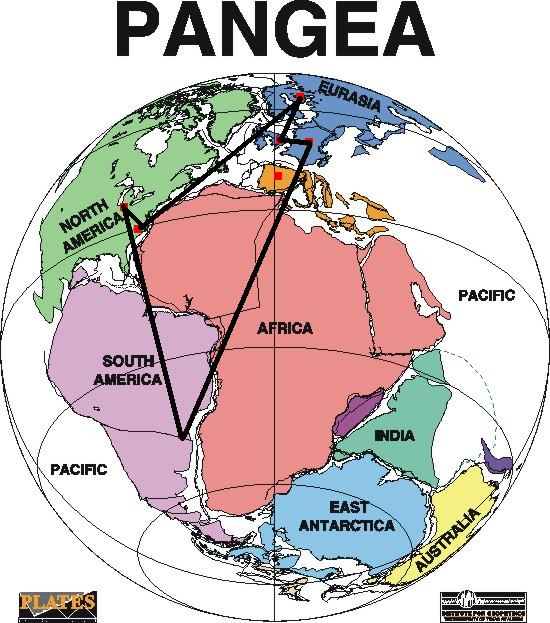Most crude oil comes from ancient marine organisms which bloomed, died, sank, and were covered by sediment to transform under conditions of heat and pressure into petroleum. The organisms required sunshine, CO2, and nutrients -- plus sedimentary cover. These conditions were best met in tropical seas which received nutrient-rich outflows from either rivers or rich sea currents and upwellings.
But rivers supply both nutrients and sediment, so it makes sense to look to areas which were offshore from ancient river deltas. Above, you can see the main rivers of the modern world.
But the continents of the Earth were not always in their current relationship to each other. 250 mya the continents were situated close together in a formation now referred to as Pangaea. The geology of the landmasses of that time were somewhat different, meaning that different rivers flowed into different seas.
This movement of the continents in relation to each other is caused by plate tectonics, a dynamic phenomenon which is largely controlled by actions at the bottom of the seas.
The graphic above is meant to illustrate possible sites for "abiotic oil" deposits, but if you look carefully at the oceans, you can find seafloor ridges which are ground zero for the motion of the continents. New seafloor -- as molten lava which cools and solidifies in contact with seawater -- is pushed upward from beneath the ocean crust, causing a spreading of the ocean crust outward. Eventually the ocean crust is pushed into contact with thicker continental crust, where it subducts -- dives downward into the mantle. This subduction is associated with volcano formation, and other geologic changes, such as slow movement of the continental plates.
This "dance of the continents" is likely to bring the land masses together again in the future, over and over again in different formations. This is important in relation to where very old oil deposits are likely to be found, and where large future deposits of oil are likely to be formed in their turn.
For example, why is oil often found in deserts and arctic wastes?
Oil and gas result mostly from the rapid burial of dead microorganisms in environments where oxygen is so scarce that they do not decompose. This lack of oxygen enables them to maintain their hydrogen-carbon bonds, a necessary ingredient for the production of oil and gas. Newly developing ocean basins, formed by plate tectonics and continental rifting, provide just the right conditions for rapid burial in anoxic waters. Rivers rapidly fill these basins with sediments carrying abundant organic remains. Because the basins have constricted water circulation, they also have lower oxygen levels than the open ocean. For instance, the Gulf of California, an ocean basin in development, is making new oil and gas in real time today. The Gulf of Mexico is also a great example of new oil and gas formation in a restricted circulation environment (see image at right above).Similar detective work may lead prospectors to rich petroleum deposits lying between Norway, Iceland, and Greenland. By the same logic applied to more recent timelines, oil and gas in the South China Sea is likely to be discovered.
The same plate tectonics that provides the locations and conditions for anoxic burial is also responsible for the geologic paths that these sedimentary basins subsequently take. Continental drift, subduction and collision with other continents provide the movement from swamps, river deltas and mild climates--where most organics are deposited--to the poles and deserts, where they have ended up today by coincidence. In fact, the Libyan Sahara Desert contains unmistakable glacial scars and Antarctica has extensive coal deposits--and very likely abundant oil and gas--that establish that their plates were once at the other ends of the earth (see image at right). _SciAm
As the SciAm article above explains, when a river flows into a limited basin -- such as the Gulf of Mexico -- oil and gas formation are most likely to occur due to rapid sedimentation. But thanks to plate tectonics and shifting continents and river-beds, many areas where rivers once flowed into limited basins have become something completely different, today.
It is no challenge to find oil where crude is already seeping to the surface. That was the case in the early days of oil discovery in the US, the Persian Gulf, and Central Asia. But to find the oil of ancient seas -- that is a challenge. Particularly since that is where most of the world's oil awaits.




No comments:
Post a Comment